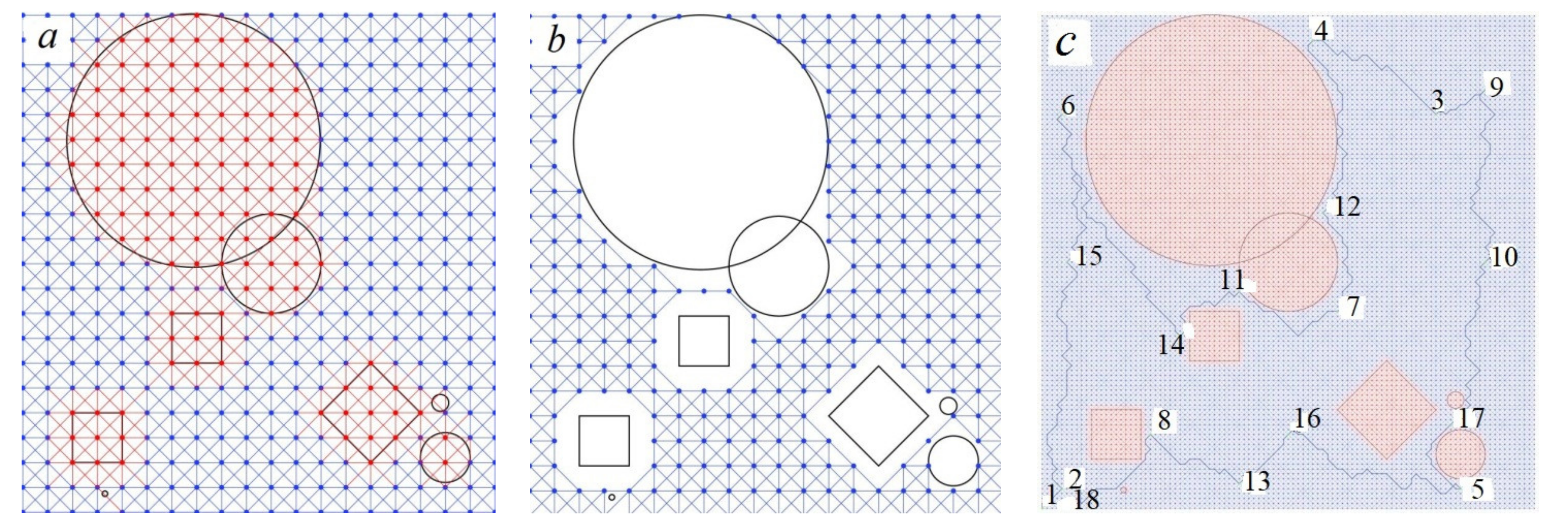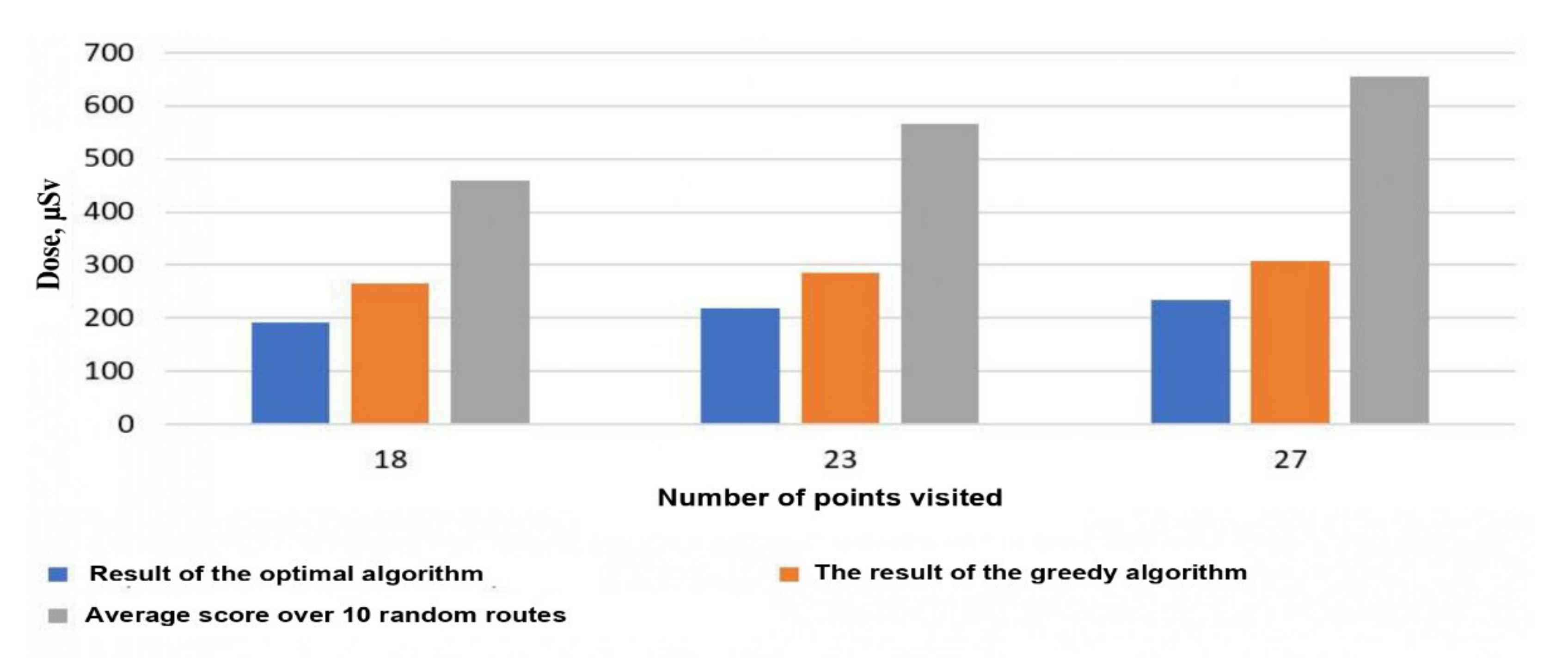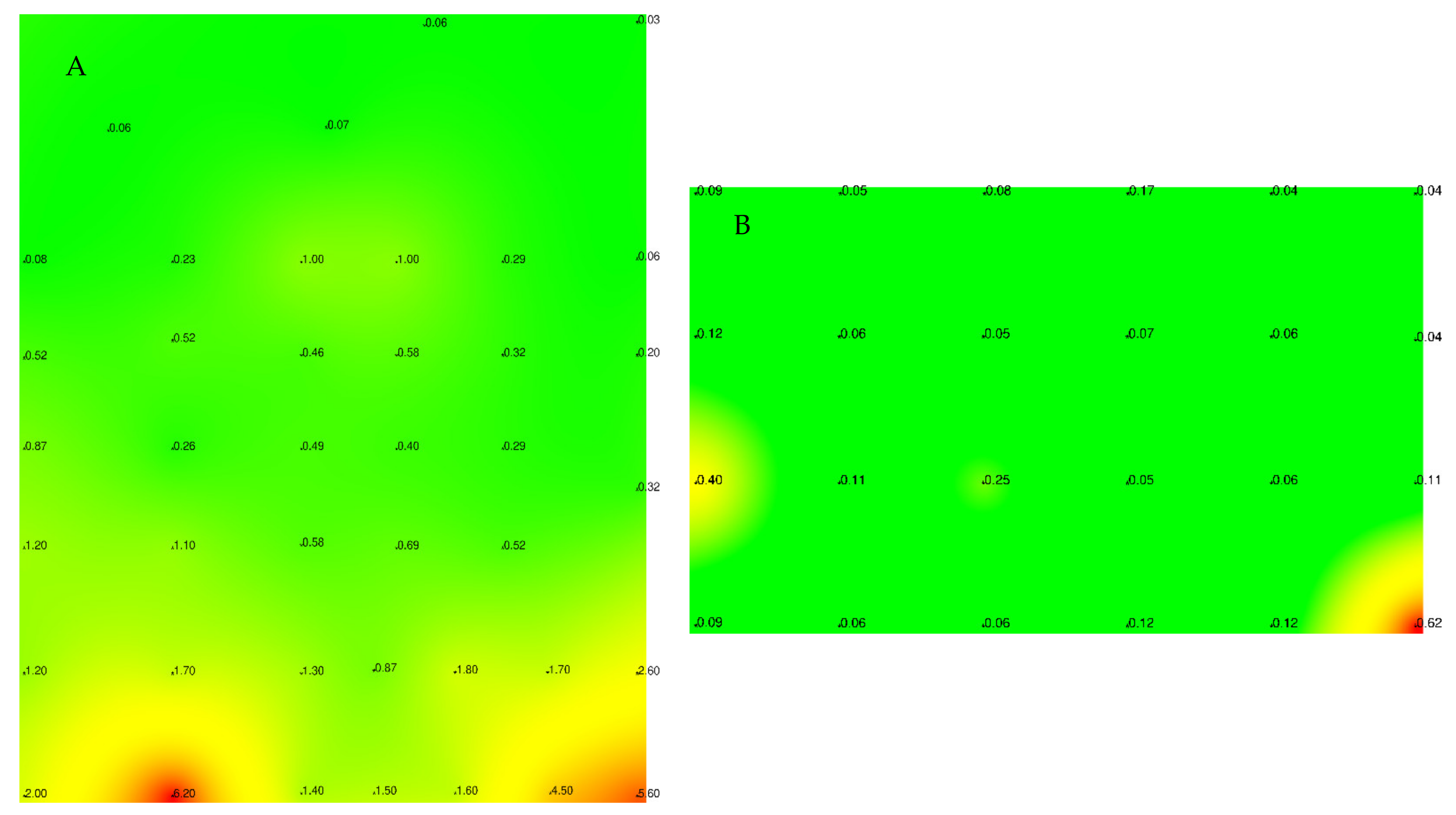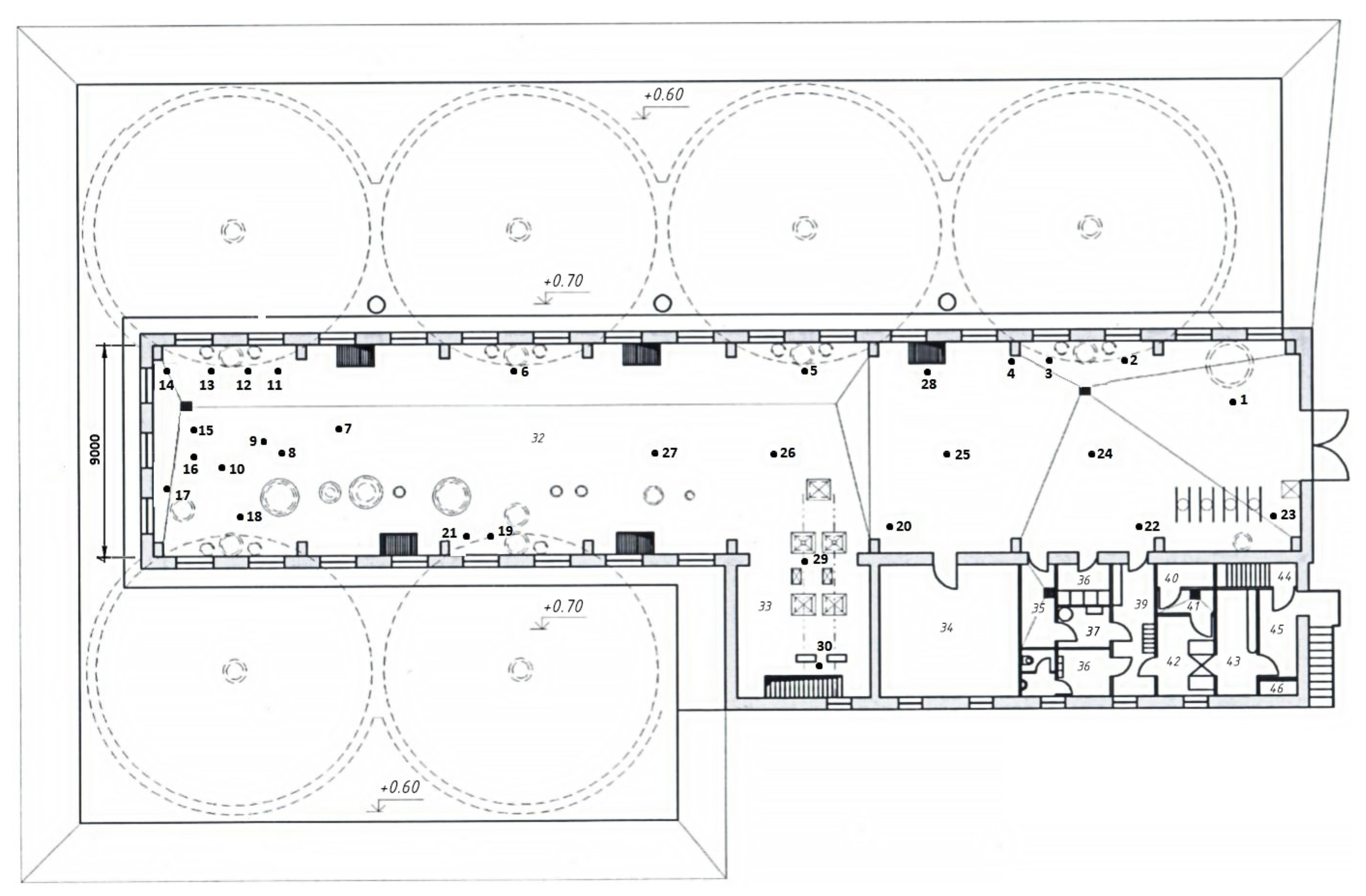Reducing the Exposure Dose by Optimizing the Route of Personnel Movement When Visiting Specified Points and Taking into Account the Avoidance of Obstacles
Abstract
1. Introduction
2. Methods and Technologies
- The dosimetrist must first perform several measurements in the room where a team or a worker intends to work.
- The radiation map of the room is drawn based on the preliminary measurements.
- Facilities to be maintained (visited) by a nuclear power plant’s employees are assigned.
- Based on the data obtained at the second step, the functions of the cost of movements between previously selected objects are calculated, considering bypassing possible obstacles, as well as the terminal function.
- The optimal route for the performer to visit all designated objects is built, considering possible restrictions in the form of antecedent conditions.
3. General Designations and Task Statement
3.1. Building a Radiation Map of the Room
3.2. Solution Diagram Based on Radial Basis Functions
- (a)
- Linear
- (b)
- Cubic
- (c)
- Quintic
- (d)
- ThinPlate
3.3. Building a Cost Function
- At the first stage, we take a plan of the area with the increased level of radiation or an NPP room. We mark on it the objects that cannot be passed through, i.e., obstacles. We also highlight the points that need to be visited. Next, we build a quite fine grid on this plan, which completely covers it (Figure 2a). The nodes of this grid are discarded where it covers obstacles (Figure 2b). The grid spacing depends on the accuracy with which we want to achieve the values of the cost function. The smaller the grid spacing, the more accurate result we get, but at the same time, the counting time increases.
- Next, we move on to the construction of an undirected graph. The vertices of the graph are nodes of the constructed grid, and the edges are its faces.
- The shortest path problem on a graph can be defined for an undirected, oriented, or mixed graph. In our case, the setting of the problem for an undirected graph is considered.
3.4. Computational Experiment
4. Results and Discussion
5. Conclusions
Author Contributions
Funding
Conflicts of Interest
References
- Available online: www.isoe-network.net (accessed on 1 February 2022).
- Tashlykov, O.L.; Shcheklein, S.E.; Sharifyanov, E.V. Innovative direction of the development of nuclear power in Russia and in the world (Environmental acceptability of nuclear power of the XXI century). Int. Sci. J. Alter. Energy Ecol. 2020, 350–352, 47–56. [Google Scholar]
- Mikhailova, A.F.; Tashlykov, O.L. Improvement of automated collection, storage and data processing system of individual dosimetric control of INM JSC personnel. PAST Ser. Mater. Technol. New Mater. 2019, 5, 64–73. [Google Scholar]
- Mikhailova, A.F.; Tashlykov, O.L. The ways of implementation of the optimization principle in the personnel radiological protection. Phys. Atom. Nucl. 2020, 83, 1718–1726. [Google Scholar] [CrossRef]
- Tashlykov, O.L.; Shcheklein, S.E.; Lukyanenko , V.Y.; Mikhajlova, A.F.; Seleznyov, E.N.; Kozlov, A.V. Optimization of radiation protection composition. Izvestiya Vuzov Yadernaya Energetika 2015, 4, 36–42. [Google Scholar]
- Tashlykov, O.; Shcheklein, S.; Russkikh, I.; Seleznev, E.; Kozlov, A. Composition optimization of homogeneous radiation-protective materials for planned irradiation conditions. Atom. Energy 2017, 121, 303–307. [Google Scholar] [CrossRef]
- Russkikh, I.; Seleznev, E.; Tashlykov, O.; Shcheklein, S. Experimental and theoretical study of organometallic radiation-protective materials adapted to radiation sources with a complex isotopic composition. Phys. Atom. Nucl. 2015, 78, 1451–1456. [Google Scholar] [CrossRef]
- Chentsov, A.G. On a parallel procedure for constructing the Bellman function in the generalized problem of courier with internal jobs. Autom. Remote Control 2012, 73, 532–546. [Google Scholar] [CrossRef]
- Chentsov, A.G.; Chentsov, A.A. On the problem of obtaining the value of routing problem with constraints. J. Autom. Inf. Sci. 2016, 6, 41–54. [Google Scholar]
- Nosov, Y.V.; Rovneiko, A.V.; Tashlykov, O.L.; Shcheklein, S.E. Decommissioning Features of BN-350, -600 Fast Reactors. At. Energy 2019, 125, 219–223. [Google Scholar] [CrossRef]
- Tashlykov, O.L.; Sesekin, A.N.; Chentsov, A.G.; Chentsov, A.A. Development of Methods for Route Optimization of Work in Inhomogeneous Radiation Fields to Minimize the Dose Load of Personnel. Energies 2022, 15, 4788. [Google Scholar] [CrossRef]
- Chentsov, A.G.; Sesekin, A.N.; Shcheklein, A.N.; Tashlykov, O.L. On One Modification of Traveling Salesman Problem Oriented on Application in Atomic Engineering. Am. Inst. Phys. Conf. Proc. 2010, 1293, 197–202. [Google Scholar]
- Sesekin, A.N.; Tashlykov, O.L.; Shcheklein, S.Y.; Chentsov, A.G. Route optimization in the removal of radiation hazards. WIT Trans. Ecol. Environ. 2014, 190, 919–926. [Google Scholar]
- Kropachev, Y.A.; Tashlykov, O.L.; Shcheklein, S.E. Optimization of radiation protection at the stage of nuclear power plant units decommissioning. Izv. Vuzov Yad. Energ. 2019, 1, 119–130. [Google Scholar]
- Kropachev, Y.A.; Tashlykov, O.L.; Sesekin, A.N.; Shcheklein, S.E.; Khomyakov, A.P. The automated data processing subsystem for unscheduled measurements of radiological environment. Nucl. Radiat. Saf. 2019, 93, 26–35. [Google Scholar]
- Dijkstra, E.W. A Note on Two Problems in Connexion with Graphs. Numer. Math. 1959, 1, 269–271. [Google Scholar] [CrossRef]
- Grigoryev, A.M.; Tashlykov, O.L. Solving a routing optimization of works in radiation fields with using a supercomputer. AIP Conf. Proc. 2018, 2015, 020028. [Google Scholar] [CrossRef]
- Chentsov, A.G.; Grigoryev, A.M. A scheme of independent calculations in a precedence constrained routing problem. In Discrete Optimization and Operations Research; DOOR 2016; Lecture Notes in Computer Science; Springer: Berlin/Heidelberg, Germany, 2016; Volume 9869, pp. 121–135. [Google Scholar]
- Chentsov, A.G.; Grigoryev, A.M. Dynamic programming method in the route problem: The scheme of independent calculations. Mekhatronika Avtom. Upr. 2016, 17, 834. [Google Scholar] [CrossRef]
- Bellman, R. Dynamic Programming Treatment of the Travelling Salesman Problem. J. Assoc. Comput. Mach. 1962, 9, 61–63. [Google Scholar] [CrossRef]
- Held, M.; Karp, R.M. A Dynamic Programming Approach to Sequencing Problems. J. Soc. Ind. Appl. Math. 1962, 10, 196–210. [Google Scholar] [CrossRef]
- Chentsov, A.G. Extreme Problems of Routing and Tasks Distribution; NIC Reguljarnaja i Haoticheskajadinamika: Izhevsk, Russia, 2008. (in Russian) [Google Scholar]
- Chentsov, A.A.; Chentsov, A.G.; Chentsov, P.A. Elements of dynamic programming in extremal route problems. Problemyupravlenija 2013, 5, 12–21. (In Russian) [Google Scholar]
- Biancolini, M.E. Fast Radial Basis Functions for Engineering Applications; Springer: Berlin/Heidelberg, Germany, 2018. [Google Scholar]
- Buhmann, M.D. Radial Basis Functions: Theory and Implementations; Cambridge University Press: Cambridge, UK, 2003. [Google Scholar]
- Grigoryev, A.M.; Tashlykov, O.L. Route optimization during works in non-stationary radiation fields with obstacles. AIP Conf. Proc. 2019, 2174, 020216. [Google Scholar]
- Grigoryev, A.M.; Tashlykov, O.L.; Popel, A.A.; Kropachev, Y.A. Determination of radiation field parameters for the problems of routing optimization based on interpolation with radial basis functions. AIP Conf. Proc. 2020, 2313, 020007. [Google Scholar] [CrossRef]








| Radial Basis Functions | ||||
|---|---|---|---|---|
| Cubic | Linear | Quintic | ThinPlate | |
| All measurements | 8.55674 | 9.2007 | 8.40472 | 8.59993 |
| 80% measurements | 7.97714 | 8.78118 | 7.02262 | 8.16382 |
| Deviation in % | 7.27% | 4.78% | 19.68% | 5.34% |
| Point | 1 | 2 | 3 | 4 | 5 | 6 | 7 | 8 | 9 | 10 | 11 | 12 | 13 | 14 | 15 |
|---|---|---|---|---|---|---|---|---|---|---|---|---|---|---|---|
| AEDR, mSv/h | 0.066 | 0.09 | 0.4 | 0.5 | 0.1 | 0.11 | 0.16 | 0.6 | 1.1 | 2.0 | 2.1 | 1.2 | 0.7 | 1.0 | 0.9 |
| Тoчка | 16 | 17 | 18 | 19 | 20 | 21 | 22 | 23 | 24 | 25 | 26 | 27 | 28 | 29 | 30 |
| AEDR, mSv/h | 1.1 | 1.7 | 0.4 | 0.3 | 0.02 | 0.3 | 0.019 | 0.03 | 0.2 | 0.1 | 0.08 | 0.09 | 0.16 | 0.009 | 0.0033 |
| Point/ Func | Linear | Cubic | Quintic | ThinPlate | Measured Value | ||||
|---|---|---|---|---|---|---|---|---|---|
| Deviation from the Real Value, mSv/h | Deviation from the Real Value in % | Deviation from the Real Value, mSv/h | Deviation from the Real Value in % | Deviation from the Real Value, mSv/h | Deviation from the Real Value in % | Deviation from the Real Value, mSv/h | Deviation from the Real Value in % | ||
| 8 | 0.0267944 | 4.47% | 0.00346935 | 0.58% | −0.0117228 | 1.95% | 0.0143474 | 2.39% | 0.6 |
| 9 | −0.00983797 | 0.89% | 0.0134573 | 1.22% | 0.0363129 | 3.30% | 0.00145992 | 0.13% | 1.1 |
| 10 | −0.106373 | 5.32% | −0.10339 | 5.17% | −0.0941109 | 4.71% | −0.106697 | 5.33% | 2 |
| 11 | −0.114607 | 5.46% | −0.0818156 | 3.90% | −0.0698758 | 3.33% | −0.0958796 | 4.57% | 2.1 |
| 12 | 0.0281054 | 2.34% | 0.0285196 | 2.38% | 0.0223563 | 1.86% | 0.0332057 | 2.77% | 1.2 |
| 13 | 0.0389322 | 5.56% | 0.00677445 | 0.97% | −0.00405566 | 0.58% | 0.01932 | 2.76% | 0.7 |
| 14 | −0.014384 | 1.44% | −0.0635085 | 6.35% | −0.00003837 | 0.00% | −0.0453361 | 4.53% | 1 |
| 15 | 0.0239413 | 2.66% | −0.0290123 | 3.22% | −0.0778416 | 8.65% | −0.00127017 | 0.14% | 0.9 |
| 16 | 0.040386 | 3.67% | 0.0540454 | 4.91% | 0.0613541 | 5.58% | 0.0495584 | 4.51% | 1.1 |
| 17 | −0.0711521 | 4.19% | −0.162506 | 9.56% | −0.1698 | 9.99% | −0.100038 | 5.88% | 1.7 |
| Average value over all points: | 3.60% | Average value over all points: | 3.83% | Average value over all points: | 3.99% | Average value over all points: | 3.30% | ||
Publisher’s Note: MDPI stays neutral with regard to jurisdictional claims in published maps and institutional affiliations. |
© 2022 by the authors. Licensee MDPI, Basel, Switzerland. This article is an open access article distributed under the terms and conditions of the Creative Commons Attribution (CC BY) license (https://creativecommons.org/licenses/by/4.0/).
Share and Cite
Tashlykov, O.L.; Grigoryev, A.M.; Kropachev, Y.A. Reducing the Exposure Dose by Optimizing the Route of Personnel Movement When Visiting Specified Points and Taking into Account the Avoidance of Obstacles. Energies 2022, 15, 8222. https://doi.org/10.3390/en15218222
Tashlykov OL, Grigoryev AM, Kropachev YA. Reducing the Exposure Dose by Optimizing the Route of Personnel Movement When Visiting Specified Points and Taking into Account the Avoidance of Obstacles. Energies. 2022; 15(21):8222. https://doi.org/10.3390/en15218222
Chicago/Turabian StyleTashlykov, Oleg L., Alexey M. Grigoryev, and Yuriy A. Kropachev. 2022. "Reducing the Exposure Dose by Optimizing the Route of Personnel Movement When Visiting Specified Points and Taking into Account the Avoidance of Obstacles" Energies 15, no. 21: 8222. https://doi.org/10.3390/en15218222
APA StyleTashlykov, O. L., Grigoryev, A. M., & Kropachev, Y. A. (2022). Reducing the Exposure Dose by Optimizing the Route of Personnel Movement When Visiting Specified Points and Taking into Account the Avoidance of Obstacles. Energies, 15(21), 8222. https://doi.org/10.3390/en15218222







